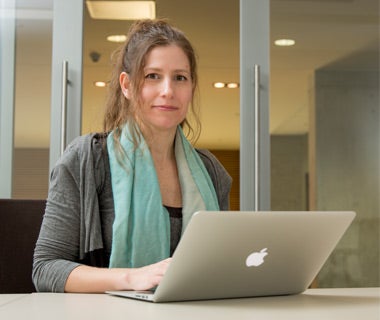
Mompreneurs: Children are the greatest risk factor for women entrepreneurs
Children actually help entrepreneurial dads stay the course but the gender difference starts to disappear when women get access to startup funds, says Waterloo economist

Children actually help entrepreneurial dads stay the course but the gender difference starts to disappear when women get access to startup funds, says Waterloo economist
By Heather Bean Marketing and Strategic CommunicationsMompreneurship is a buzzword these days for mothers looking to re-enter the workforce—or those looking for a better way to balance work and family. But in Canada, children increase the likelihood that a woman will exit the entrepreneurial market by nearly 20 percent, while children help self-employed men stay the course.
Give women greater access to startup funds, however, and that difference starts to disappear.
That’s the finding of Kathleen Rybczynski, associate professor in Waterloo’s Economics Department. In an article published in the Journal of Labour Research, Rybczynski used data from the Canadian Survey of Labour and Income Dynamics to trace the causes of self-employment success and failure for women in Canada. And while having children was the greatest risk factor for women, financial liquidity was the marker for success.

Kathleen Rybczynski
The catch is, women entrepreneurs have a harder time getting funding. On average, they have less equity. When they apply for small business loans, “Women pay higher interest rates, are required to put up more collateral, and have higher rejection rates,” says Rybczynski. This despite evidence that women may be safer credit bets: studies have found that women are more likely to pay back their loans.
When financial barriers are removed, not surprisingly, women succeed. Rybczynski found that the beneficial relationship holds across a range of obstacles: women with sufficient funds are less likely to leave the market due to business failure, and they’re more likely to stick it out through family and personal issues.
Rybczynski is also excited about other forms of credit that women can access. Micro-loans and crowd funding can provide money for businesses that larger institutions won’t support. “I’ve noticed a huge amount of really incredible projects get funded this way,” she states.
Rybczynski points out that the Prime Minister’s Task Force on Women Entrepreneurs report identified financing as their number one problem—almost twelve years ago, in 2003. To solve that problem, she suggests, financial institutions could expand loan programs specifically targeted to female entrepreneurs. More fundamentally, she adds, banks could look at their standard risk model to eliminate systemic bias against lending to women entrepreneurs.

Read more
New Canada Research Chairs will tackle future-focused problems from social robots and intergroup attitudes to geochemistry and nanoscale devices

Read more
Meet five exceptional Waterloo graduate students crossing the convocation stage as Class of 2025 valedictorians

Read more
Twenty-six researchers receive federal funding to drive discovery, innovation and research infrastructure development
The University of Waterloo acknowledges that much of our work takes place on the traditional territory of the Neutral, Anishinaabeg, and Haudenosaunee peoples. Our main campus is situated on the Haldimand Tract, the land granted to the Six Nations that includes six miles on each side of the Grand River. Our active work toward reconciliation takes place across our campuses through research, learning, teaching, and community building, and is co-ordinated within the Office of Indigenous Relations.